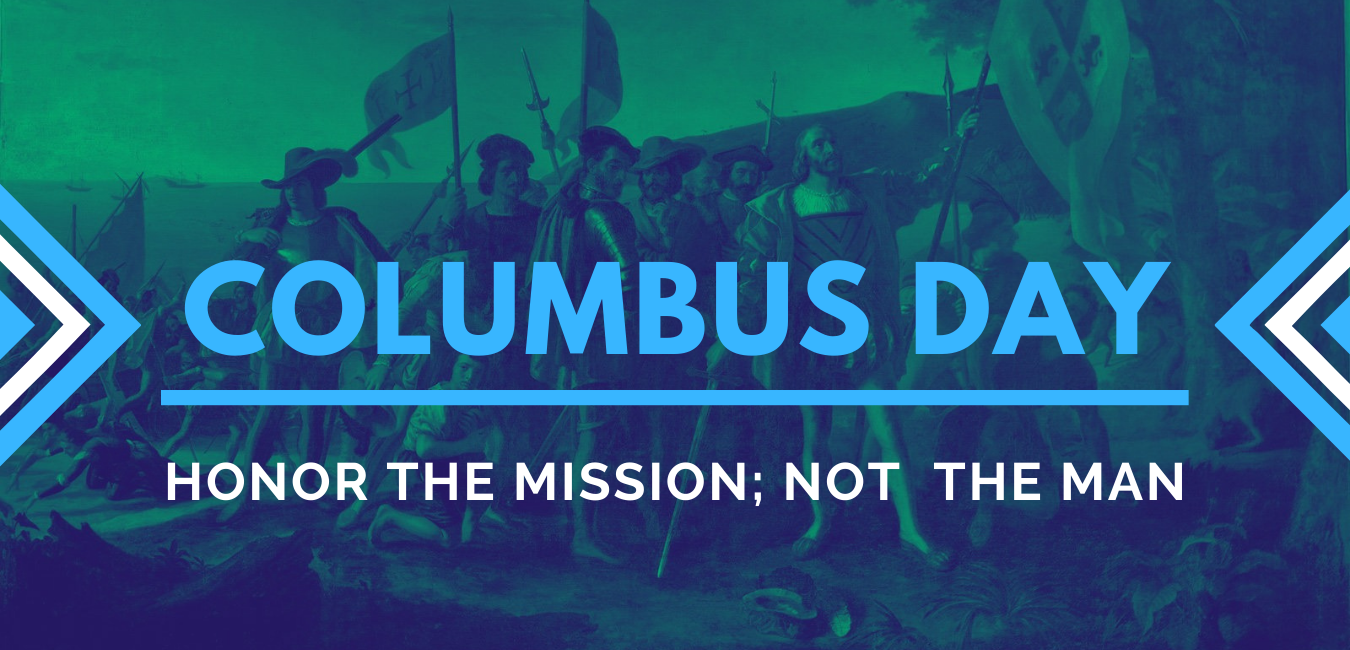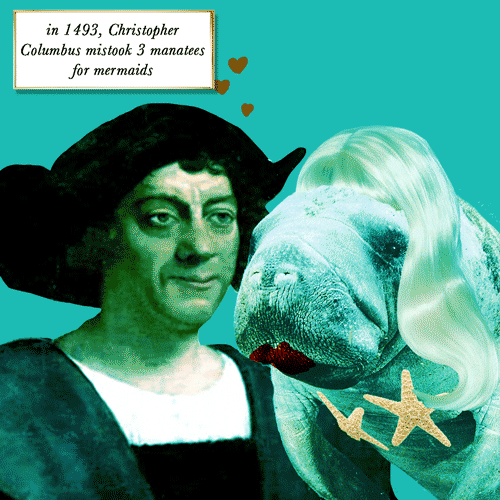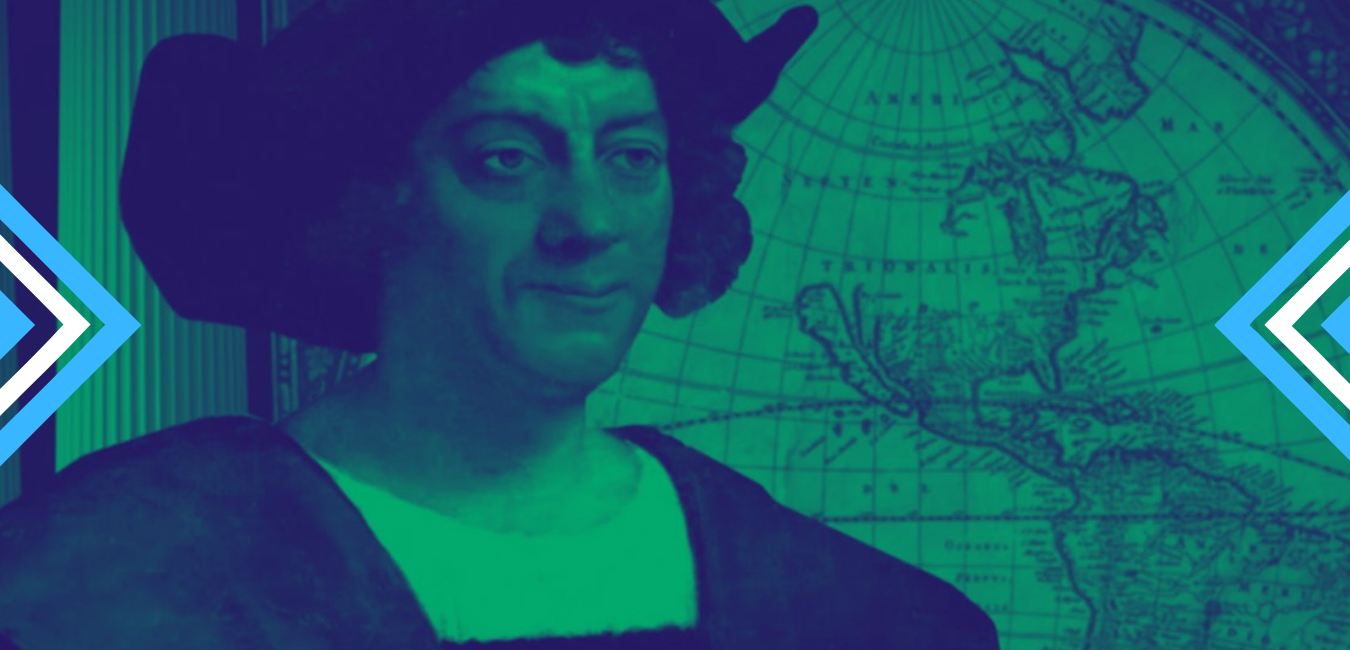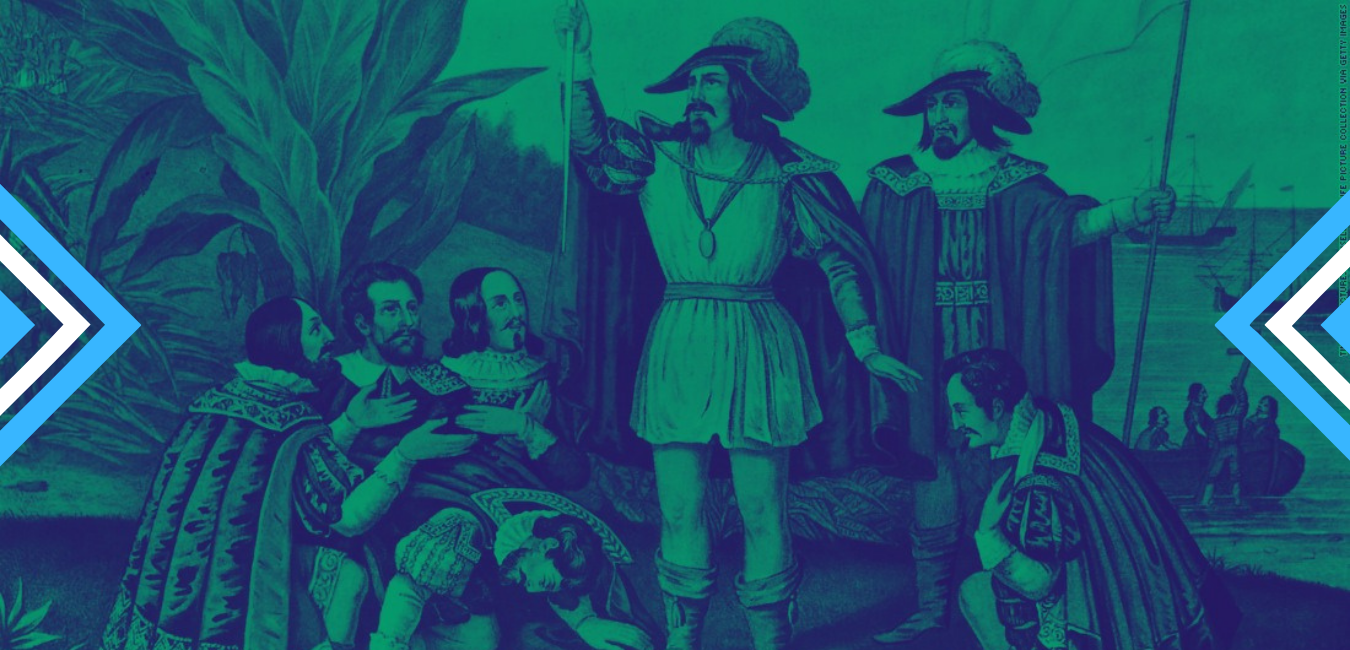|
LAST UPDATED: 11.26.21
(Disclaimer: This is not professional or legal advice. If it were, the article would be followed with an invoice. Do not expect to win any social media arguments by hyperlinking my articles. Chances are, we are both wrong). (Trigger Warning: This article or section, or pages it links to, contains antiquated language referring to people of color which may be triggering to some.) Revision is seen as a dirty word. Depending on where you are on the old-fashioned Left-Right Spectrum politically, you are terrified of a world of New Speak from the pages of George Orwell's 1984. As I have mentioned before, history is a living and breathing academic study, which changes as new information is found and new interpretations arise. Social science can also fall victim to pseudohistory if not held to a certain amount of scrutiny. It seems this week I have been reminded of how polarizing a historical figure can be. Take, for example, Christopher Columbus, the famous Italian explorer and navigator. A guy so lauded for centuries he has his own holiday. Pretty impressive to be in such a company as St. Patrick and St. Valentine. But scroll through your social media during a morning constitution. You will quickly see why it's not called "St." Columbus Day. A great deal of political dogma not only influences but actually begins to warp our sense of history. I don't think you can "same sides" everything, but I wanted to start in the middle and weigh out the scales of historical inquiry for myself. Just remember, this subject fills entire books. I don't have time for the inkling to write one myself. This will be brief as I doubt you or anyone has the attention span required to enjoy this. The first recorded celebration of Columbus Day in the U.S. took place on Oct. 12, 1792. The American Revolution created the Columbus most of us over the age of 30 learned in grade school. Before the late 18th century, he was a historical footnote with no connection to the 13 colonies. He sailed under a Spanish flag and landed in no part of the modern-day mainland United States. His "discovery' made way for the widespread exploration and colonization of the Americas, leading Columbus to become a praised figure in Italian-American culture. Yet, the need to develop a national history with no real connection to Britain arose during the Revolution. He was a blank slate on whom post-Revolution Americans could project the virtues they wanted to see in their new nation. Then, as of now, writing Columbus was one of defining what it means to be American. In 1775 Phillis Wheatley, a 14-year-old free African-American girl, wrote a poem to George Washington that so moved the general that he distributed it widely. In it, "Columbia" was used as a symbolic representation of the American nation, no doubt a riff on the female figure of Britannia. Soon Columbia and Columbus appeared in songs, poems, and essays in newspapers around the colonies. In 1891, 11 Sicilian immigrants were lynched in New Orleans after a mob blamed them for killing the city's police chief, even though a jury hadn't convicted them. Sicilians were targeted for lynching because they worked the same jobs as African Americans and often lived in their communities, leading Southerners to consider them more Black than white. The New Orleans lynching was roundly praised. Rising political star Teddy Roosevelt called it "a rather good thing." A New York Times headline was jubilant: "Chief Hennessy avenged. Eleven of his Italian assassins lynched by a mob." The Italian government was not so optimistic. It broke off diplomatic relations with the U.S. and demanded (and received) reparations. To further make up for the incident, President Benjamin Harrison in 1892 proclaimed a one-time holiday to observe the 400th anniversary of Columbus' discovery of the New World. However, Harrison didn't single out Italians but extolled Columbus as "the pioneer of progress and enlightenment." Nevertheless, that proclamation ultimately set the stage for a federal Columbus Day holiday, created in 1934. The holiday "was central to the process through which Italian-Americans were fully ratified as white during the 20th century. Still, it wasn't until 1971 that Columbus Day became a federal holiday, annually observed on the second Monday in October. Since then, Italian-Americans have held festivals and parades on that day to commemorate Columbus' voyage and his contributions. Those in favor of Columbus Day say the holiday should stay because it symbolizes Italian-American heritage and represents the beginning of Western civilization. Let's start with the good! I love the western hemisphere, especially the United States: home of Hostess Apple Pies and cheap pilsners. The voyages of Columbus are considered a turning point in world history, marking the beginning of globalization and accompanying demographic, commercial, economic, social, and political changes. His explorations resulted in permanent contact between the two hemispheres. The term "pre-Columbian" refers to the culture of the Americas before the arrival of Columbus and his European successors. The ensuing Columbian exchange saw the massive exchange of animals, plants, fungi, diseases, technologies, mineral wealth, and ideas. Old World wheat became an American food staple. African coffee and Asian sugar cane became cash crops for Latin America. At the same time, American foods like corn, tomatoes, and potatoes were introduced into European diets. So, if we stopped now, Columbus should get his statue for providing us with sugar and coffee (sometimes together!).
Biologists should also appreciate the Columbian Exchange for its role in creating novel human genomes shaped by rapid adaptive evolution. Most population genetic studies of New World human populations have focused on ancestry, utilizing sequence variants as neutral markers of evolutionary lineages. Despite the transport of new killer diseases, including the emergence of deadly syphilis in Europe and Asia, linked to trade with the Americas, the Columbian Exchange eventually allowed more people to live off the land. These newly available plants and animals led to the most significant improvement in farm productivity since the original agricultural revolution. The results of different peoples' efforts in domesticating and refining crops over thousands of years were now available and being adopted worldwide. A single globalized farming culture was born. Today, they are knitting the continents and oceans together, the opposite of the trend over the past 200 million years that has seen the continents separating. It is an important event in the context of Earth's history.
This is a more holistic perspective, viewing the human species almost as a single living organism. Columbus landing in America was the best thing to happen to humanity or the worst thing, but rather the most important. From an evolutionary standpoint, the case is undoubtedly a strong one, at least for anything that has happened in recorded history. Despite being an intrepid explorer, it's worth noting that Columbus' landfall was actually a mistake. Columbus made four trips across the Atlantic Ocean from Spain: 1492, 1493, 1498, and 1502. He was determined to find a direct water route west from Europe to Asia, but he never did. Instead, he stumbled upon the Americas. His journeys marked the beginning of centuries of exploration and colonization of North and South America. But as we march on, the lens changes. Until the 1990s, Columbus was portrayed as a heroic explorer. More recently, however, the narrative has featured the adverse effects of the conquest on native populations. Exposed to Old World diseases, the indigenous people of the New World collapsed and were largely replaced by Europeans and Africans who brought with them new methods of farming, business, governance, and religious worship. I find it interesting that we have always been sold the notion that Columbus was out to prove the world was not flat, and more egregious, that it was his theory of a round planet. Washington Irving's 1828 biography of Columbus popularized the idea that Columbus had difficulty obtaining support for his plan because many Catholic theologians insisted that the Earth was flat, but this is a popular misconception that can be traced back to the 17th-century Protestants campaigning against Catholicism. In fact, the spherical shape of the Earth had been known to scholars since antiquity. It was common knowledge among sailors, including Columbus. Coincidentally, the oldest surviving globe of the Earth, the Erdapfel, was made in 1492, just before Columbus's return to Europe. It contains no sign of the Americas and yet demonstrates the common belief in a spherical Earth. We also cannot ignore the xenophobia towards Spain that may have lent to building propaganda around the atrocities of colonization. The Black Legend is a theorized historiographical tendency consisting of anti-Spanish and anti-Catholic propaganda. Its proponents claim that its roots date back to the 16th century when it was initially a political and psychological weapon that was used by Spain's European rivals to demonize the Spanish Empire, its people, and culture, minimize Spanish discoveries and achievements, and counter its influence and power in world affairs.
But atrocities are not self-contained events. The ill-treatment of natives, which would later occur in other European colonies in the Americas, was used in the works of competing for European powers to foster hatred against the Spanish Empire. Work was first cited in English in The Spanish Colonie, or Brief Chronicle of the Actes and Gestes of the Spaniards in the West Indies, at a time when England was preparing for war against Spain in the Netherlands. All European powers which colonized the Americas, including England, Portugal, and the Netherlands, ill-treated indigenous peoples. These issues have received greater scholarly attention in recent years, and the historiographical evaluation of colonialism's effects is evolving. While it's quick to dismiss Columbus as being besmirched by the English, there are enough first-hand accounts that would deem otherwise. This point is really more semantics, but it's important to note. We should continue by burying the idea that Columbus "discovered" anything. The narrative of discovery and settlement is a dangerous myth. It implies nothing of note existed in the Americas before the arrival of Europeans, thereby justifying the continents' "civilization." This meta-narrative is how white America has justified genocide and ecological exploitation for centuries. The Norse had colonized North America around 500 years before Columbus, with some contact with Europe being maintained until about 1410. God, glory, and gold—not necessarily in that order—took post-Renaissance Europeans to parts of the globe they had never before seen. The opportunity to gain materially while bringing the Gospel to non-Christians offered powerful incentives to explorers from Portugal, Spain, England, and France to embark on dangerous voyages of discovery in the 1400s. Did the esteemed Admiral of the Ocean Sea kill almost all the Indians? Several recent scholarly studies have dispelled or substantially modified many of the numbers generated by the anti-Columbus groups, although other new research has increased them. Why the sharp inconsistencies? One recent scholar, examining the significant assessments of numbers, points to at least nine different measurement methods, including the time-worn favorite, guesstimates. Pre-Columbian native population numbers are much smaller than critics have maintained. For example, one author claims, "Approximately 56 million people died due to European exploration in the New World." For that to have occurred, however, one must start with early estimates for the population of the Western Hemisphere at nearly 100 million. Recent research suggests that that number is vastly inflated and that the most reliable figure is nearer 53 million, and even that estimate falls with each new publication. Since 1976 alone, experts have lowered their estimates by 4 million. Some scholars have even seen those figures as wildly inflated. Several studies put the native population of North America alone within a range of 8.5 million (the highest) to a low estimate of 1.8 million. If the last number is valid, it means that the "holocaust" or "depopulation" that occurred was 1/50 of the original estimates or 800,000 Indians who died from disease and firearms. Although that number is a universe away from the forecast of 50 to 60 million deaths that some researchers have trumpeted, it still represented the destruction of half the native population. Even then, the guesstimates involve such things as accounting for the effects of epidemics—which other researchers, using the same data, dispute ever occurred—or expanding the sample area to all of North and Central America. However, estimating the number of people alive in a region five hundred years ago has proven difficult, and recently several researchers have called into question most early estimates. Some suggest that Indians may have had a nonvenereal form of syphilis, and almost all agree that a variety of infections were widespread. Tuberculosis existed in Central and North America long before the Spanish appeared, as did herpes, polio, tick-borne fevers, giardiasis, and amebic dysentery. Though the Old World contributed to its diseases, the New World certainly was not the Garden of Eden some have depicted. As one might expect, others challenged Dobyns and the "early epidemic" school, but the point remains that experts are divided. Many now discount the notion that massive epidemics swept through Central and North America; smallpox, in particular, did not seem to spread like a pandemic. There is little evidence available for estimating the numbers of people before the Europeans because, in general, natives did not keep written records. Later, when whites could document oral histories during the Indian wars on the western frontier, they found that different tribes exaggerated their accounts of battles in totally different ways, depending on tribal custom. Some, who preferred to emphasize bravery over brains, inflated casualty numbers. Others, viewing large body counts as a sign of weakness, deemphasized their losses. What is certain is other natives killed that vast number of natives and that only the absence of guns prevented the numbers of natives killed by other natives from growing even higher. Large areas of Mexico and the Southwest were depopulated more than a hundred years before the arrival of Columbus. Many historians believe that many areas of the Greater Southwest were abandoned or largely depopulated over a century before Columbus's fateful discovery due to climatic shifts, warfare, resource mismanagement, and other causes. Indeed, a new generation of scholars puts more faith in early Spanish explorers' observations of widespread ruins and decaying great houses" that they contended had been abandoned for years. European scholars have long appreciated the dynamic of small-state diplomacy. What has been missing from the discussions about native populations has been a recognition that, in many ways, the tribes resembled the small states in Europe: they concerned themselves more with traditional enemies (other tribes) than with new ones (Europeans). In conjunction with these facts, it would also be entirely fair to label Columbus as one of the "founding fathers" of the trans-Atlantic slave trade. Meanwhile, Spain's monarchs broadly granted colonists dominion over Amerindian subjects, compelling native populations to pay tribute, often in the form of labor. The latter practice was primarily an extension of the medieval encomienda, a quasi-feudal system in which Iberian Christians who had performed valuable military service were granted authority to govern people and resources in lands conquered from Iberian Muslims. Also, despite their objection to a trans-Atlantic slave trade of Amerindians, the Crown permitted their outright enslavement and sale within the Americas. During the first half of the sixteenth century, Spanish colonists conducted raids throughout the Caribbean, bringing captives from Central America, northern South America, and Florida back to Hispaniola and other Spanish settlements. Two of the principal arguments used to justify the enslavement of Amerindians were the concepts of "just war." For example, the notion that anyone who refused to accept Christianity, or rebelled against Spanish rule, could be enslaved. Also, they could "rescue" or ransom, which is the idea that Amerindians held captive by other groups could be purchased to Christianize them and rescue them from captors who were allegedly cannibals. Now the next part gets a little rough. Columbus is on record performing some rather heinous acts during his tenure in the New World. When Columbus and his sailors came ashore in 1492, the Arawaks ran to greet them, brought them gifts. He later wrote of this in his log: They ... brought us parrots and balls of cotton and spears and many other things, which they exchanged for the glass beads and hawks' bells. They willingly traded everything they owned... . They were well-built, with good bodies and handsome features... They do not bear arms and do not know them, for I showed them a sword, they took it by the edge and cut themselves out of ignorance. They have no iron. Their spears are made of cane... . They would make fine servants... With fifty men we could subjugate them all and make them do whatever we want.
But it wasn't just Columbus that ratted himself out. The chief source-and, on many matters, the only source of information about what happened on the islands after Columbus came is Bartolome de las Casas, who, as a young priest, participated in the conquest of Cuba. Las Casas transcribed Columbus's journal and, in his fifties, began a multivolume History of the Indies. In it, he describes the Indians. Total control led to absolute cruelty. "(The Spaniards) thought nothing of knifing Indians by tens and twenties and of cutting slices off them to test the sharpness of their blades... two of these so-called Christians met two Indian boys one day, each carrying a parrot; they took the parrots and for fun beheaded the boys." We also seem to glance over Columbus, the ruler, and tyrant as opposed to the explorer. As governor and viceroy of the Indies, Columbus imposed iron discipline on the first Spanish colony in the Americas, in the Caribbean country of the Dominican Republic. Punishments included:
Physical mutilation was one of his many tricks of the trade. One man caught stealing corn had his nose and ears cut off, was placed in shackles, and was auctioned off as a slave. A woman who dared to suggest that Columbus was of lowly birth was punished by his brother Bartolomé, who traveled to the Caribbean. She was stripped naked and paraded around the colony on the back of a mule. It was before too long that Columbus made powerful enemies. Evidence has been found in a previously lost report drawn up for the Spanish monarchs. They became worried by growing rumors of Columbus' barbarity and avarice. The document was written by a member of an order of religious knights, the Order of Calatrava, who had been asked to investigate the allegations against Columbus by Queen Isabella and King Ferdinand, who ruled Spain together at the time. Official Spanish documents lay bare fruits of Columbus and his labors as ruler. The report, by Francisco de Bobadilla, lay undiscovered in a state archive in the Spanish city of Valladolid until 2005. Bobadilla had already been named governor of the Indies, replacing Columbus at the report. Bobadilla collected the testimonies of 23 people who had seen or heard about the treatment meted out by Columbus and his brothers. Needless to say, this did not go over well. So horrific was Columbus's governorship of Hispaniola that he was shipped back to Spain in irons, stripped of his titles, and imprisoned for several weeks. If anyone tries to tell you that anti-Columbus sentiment is a newer Leftist sentiment, kindly point them in the direction of the 16th-century witchhunt that gave his political career a death rattle. Columbus actually opened up political debate during his time. His death in Valladolid, Spain, in 1506 led to the first-ever European reckoning of colonization, known as the Valladolid debate, in 1550. Spain's colonization and conquest of the Americas inspired an intellectual discussion, especially regarding the compulsory Christianization of the Indians. Bartolomé de las Casas worked for years to oppose forced conversions and expose the treatment of natives encomiendas (a Spanish labor system that rewarded conquerors with the labor of particular groups of conquered non-Christian people). His efforts influenced the papal bull Sublimis Deus of 1537, which established the status of the Indians as human beings. More significantly, Las Casas was instrumental in passing the Laws of the Indies of 1542, which were designed to end the encomienda system. There are also "quotes" reinforcing other myths by taking single sentences of Columbus's writings to portray him as a monster. From racist to a child trafficker, Columbus is accused of a whole host of atrocities relying on "citations" from his journal to prove the point. Columbus offended the Indians, based on the quote: "Savage cannibals, with dog-like noses that drink the blood of their victims." Alleged to be Columbus's description of natives, in reality, this was Columbus's recording of the description given by Taino Indians about the cannibal Carib tribe. Columbus himself dismissed these claims as exaggerations until he and his men came across a village of cannibals and found body parts of men being cooked. Columbus despised the Indians, based on the quote: "For with fifty men they can all be subjugated and made to do what is required of them." This entry is presented to try and depict Columbus as a power-hungry conquistador evaluating potential Indian victims. In reality, Columbus was relating to the Monarchs how establishing fortresses to protect trade routes did not seem necessary because the islands seemed relatively safe. Later experience proved the natives could be quite war-like. However, this initial observation is still misquoted to try and paint him as a ruthless conqueror despite his explicitly friendly gestures towards the Indians. "[He] sold children into sexual bondage." This particular falsehood would be laughable were it not so egregious. The lie has its origin in a letter Columbus sent back to Spain wherein he states: "There are plenty of dealers who go about looking for girls; those from nine to ten are now in demand, and for all ages, a good price must be paid." An appalling indictment. However, citing this quote out of context removes one vital component of the text: Columbus is explicitly complaining to the Monarchs of this atrocity. His very following paragraphs states that these traffickers "did not deserve water in the sight of God or the world." Far from engaging in such activity, Columbus tried to suppress this behavior on his return to Hispaniola and begged the Monarchs to send more upright men as colonists. Despite this, some cite this quote out of context to create the narrative that Columbus somehow approved of child exploitation. Anyone who bothers to read the text they are citing can see this through this falsehood. The deception of those who persist in spreading this lie is staggering, particularly given how easily the truth is verified. The current state of the world is tribalism. It seems that we cannot help but throw ourselves into a camp and be prepared to defend that tribe's dogma. We will die on hills all day long just to prove someone wrong if need be. People seem to use confirmation bias to build their own preconceived notion of history, and that is, unfortunately, spreading like a virus. I ask that as scholars and as free thinkers, keep this animalistic nature in check. Don't be in a tribe, be an intellectual vagabond. Be a hobo that rides the rails of historical discovery. As far as my final adjudication of Christopher Columbus, man is fallible. Capable of changing the world for the better or worse. But I ask a rhetorical question: Should a person be given a statue or holiday if they were shackled for their crimes against humanity?
0 Comments
Leave a Reply. |
AuthorRyan Lancaster wears many hats. Dive into his website to learn about history, sports, and more! Archives
April 2024
Categories |





 RSS Feed
RSS Feed